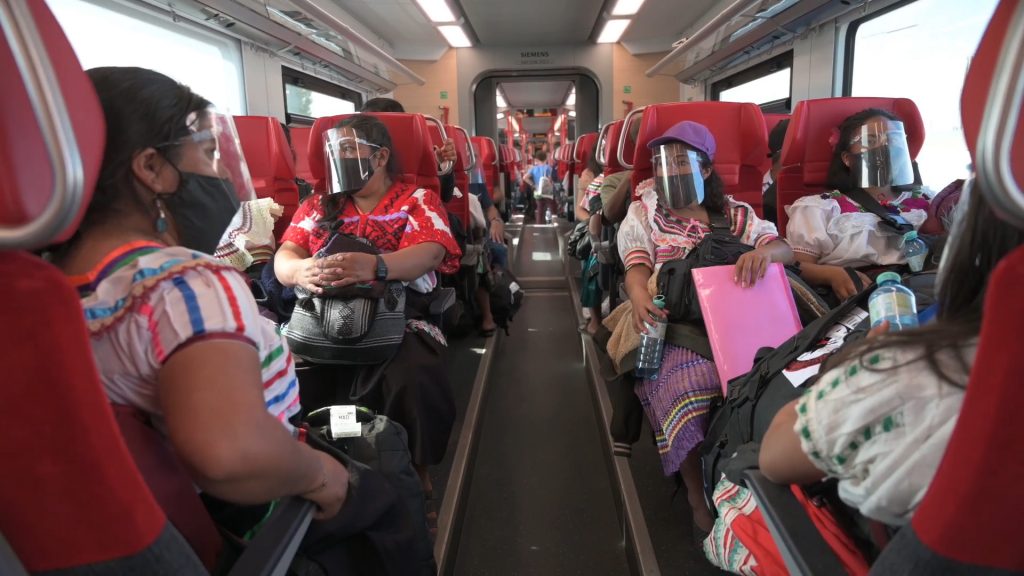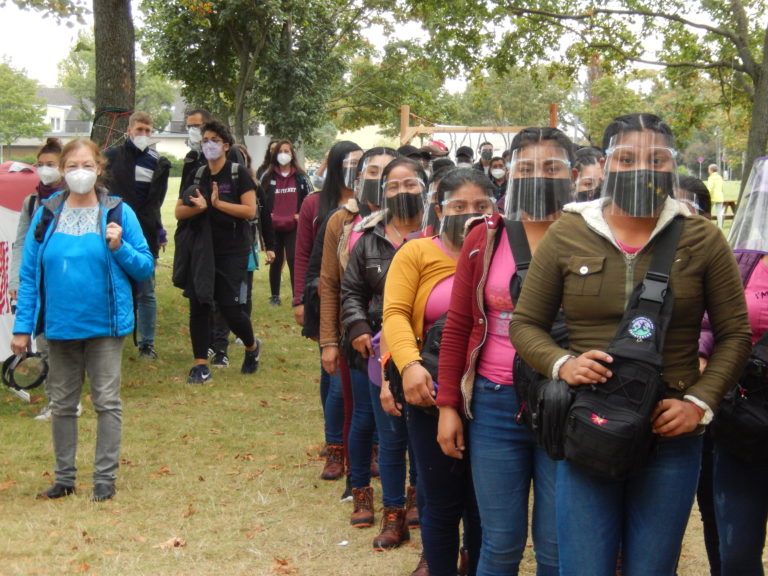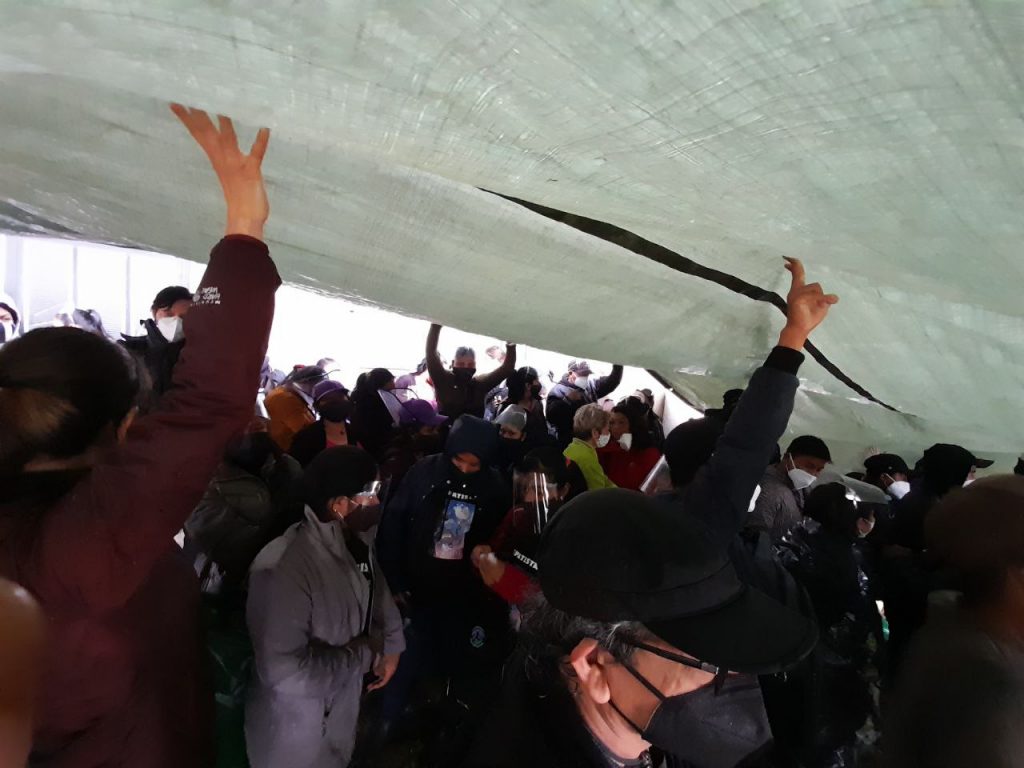Account of the Zapatistas’ arrival in Vienna and their first days in Europe~ 32 min

By Francisco Norega with Independent Media in Vienna
Translated to English by Ana Sophie and Ana Cristino
The aerial delegation La Extemporánea (meaning untimely, out of time) arrived in Europe a few days after the return to Mexico of Escuadrón 421 (Squad 421). Before they split into groups to cover all territories of Europe they were invited to visit, they participated in gatherings with several movements, organizations and internationalists in the Austrian capital, as well as in various protests. Their arrival was marked by the kidnapping of two Zapatista compas from the Council of Good Government in Patria Nueva, Chiapas, a territory on the verge of civil war, where the Zapatista communities of Mayan roots are facing an increasing number of aggressions by paramilitary groups and narcotraffickers.
In the middle of Central Europe, on the 14th of September 2021, one hundred Zapatista women, men and children landed in Vienna, Austria, European Union’s sixth most populated city, near the borders with Hungary, Czech Republic, and Slovakia. Organized, with passports, vaccines, sanitary protocols, quarantine, complete documentation and tickets in hand, the Zapatista compas were able to break the transatlantic racism that tried everything to prevent this trip. The racism from a Mexico that considers its originary peoples “extemporáneos” (in the sense of “inopportune, inconvenient”, of “one which does not belong to these times”) and the racism from Fortress Europe that, hiding behind sanitary regulations, doesn’t consider hundreds of gatherings with hundreds of organizations, peoples, and movements in the entire continent a case of force majeur to grant the entry of this delegation of 177 Zapatistas.
At the Vienna airport, dozens of collectives from Vienna and from all over Europe—or Slumil K’ajxemk’op (“Unsubmissive Land” in a Mayan language), as the continent was rebaptized by Escuadrón 421 when they arrived in Vigo on the 22nd of June—, were anxiously waiting for the first group of La Extemporánea. The aerial delegation crossed the arrivals doors around noon, amidst applauses and chants of “Zapata vive, la lucha sigue!” (Zapata lives, the struggle goes on), “EZLN”, “Los pueblos unidos jamás serán vencidos” (The peoples united will never be defeated) and revolutionary songs in various languages.

Outside the Vienna airport, the Zapatista delegation was welcomed with much emotion and warm words by Austrian women and migrants who welcomed them “to your home” in German and Spanish. Without taking his backpacks off, Subcomandante Insurgente Moisés took the microphone to address his hosts in Europe and speak about defending nature and Mother Earth. “Nature will perish. This is what we came to tell you. Don’t you believe it? You will see it,” he warned. “Its name we already know: it’s capitalism. It is capitalism that is destroying life and nature.” With a blue shirt, cap, sanitary protection visor, and the face covered only by a mask, dispensing for the first time the red bandana and the balaclava, Subcomandante Insurgente Moisés was applauded during his 13-minute speech.
“We, the Zapatistas, are here thanks to our compas who fell in the uprising of 1994 when we came out to fight against the bad government (…) We are here thanks to the compas who fell resisting and rebelling. Our rebellion, our resistance, is that we want to govern ourselves as peoples. (…) We don’t want to kill, we don’t want to die. The problem is that they don’t give us the opportunity to do it the way we, as men and women, think it should be. And it’s what we have been doing for 28 years: we are not shooting, we are not killing, and we don’t want to die. We want Life,” states the spokesperson of EZLN.

Under a surprisingly strong sun for this time of the year in this geography, the Mayan women protected themselves from the intense heat with files full of documents, proof of their struggle to enter Europe. After the speech, they found shelter in the shadow of a building and rested while the groups got organized to bring the compas to their accommodations in different neighbourhoods of Vienna, to where they travelled by public transportation.
The Zapatista Airforce landed in an unsubmissive land of which the history of pain and resistance goes beyond the waltzes and the Rococo palaces at the margins of the Danube River, the largest one in Europe after the Volga River. Ricardo Loewe, from the Solidarity Committee Mexico-Salzburg, explained to the independent media that, “Together with Poland and Hungary, Austria is a country from the former empire of the Habsburgs that today carries the flag of Europe’s racism; it is more than sad, it’s outrageous, enraging, because there are dramatic reminiscences of fascism here that are still felt. And, nonetheless, we are receiving the Zapatista delegation; it is not a coincidence that they are coming to Vienna, where there are many groups that have great sympathy for the Zapatismo.”
Apart from the Imperial Crypt where tourists can visit the tomb of Maximilian, Archduke of Vienna and Holy Roman Emperor from 1493 to 1519, the Ethnographic Museum exhibits its eurocentrism and colonial narrative “with the Moctezuma Penacho (headdress) that looks like a dead chicken, lying down, because it is falling apart.” The words of Loewe remind us also of the past of “red Vienna”, prior to the fascist dictatorship of Dolfus, as well as the crystalized Austrian Marxism, for example, in the Friedrich Engels Square and the multifamily complex Karl-Marx-Hof. The 80-year-old Austrian compa also remembers the feminist and queer movements, the squatting movement, and the culture of the anarcho-communist struggle, “small but well structured, nonpartisan.”
Some people waited at the airport for the reception of the second group, expected by late afternoon on the 14th of September. Although this group didn’t manage to embark in Madrid on the connection flight to Vienna, the cultural act was held as planned. Apart from music, poetry, percussion and collective chants, there were also interventions in various languages that expressed not only the revolt about the second group not having been able to board in Madrid, but also the joy of the awaited arrival. A migrant compa exclaimed vehemently, “If the Zapatistas are stuck in Madrid, in the heart of colonialism, then we should go for them, even if we have to walk there!”
It wasn’t necessary because, the day after, also around noon, more than 70 Zapatista men landed and joyfully formed a line that left the airport of the Austrian capital in yet another sunny morning. A few meters from the door of the international arrivals, a group of migrant hosts took the floor:
Dear Compas, the migrants of Spanish and Portuguese language in the geography of Vienna greet and welcome you! We are a collective that has gathered to meet and accompany you, the Zapatista delegation. We want to make sure that the voice of migrants is heard in the different fronts of the organization of the Journey for Life in Austria. We asked ourselves, ‘How would we have liked to be received when arriving from the other side of the ocean?’ And the answer was that someone could have said the following words to us, ‘we, the precarious, we, the racialized, we who fight for a migrant voice, we that speak German with an accent in the geography called Vienna, greet and welcome you! Our home is your home.’
By CompasZapatistas, collective of migrant people in Vienna
The streaming team installed itself for two consecutive days in front of the doors of the international arrivals under the incredulous looks of travellers and airport police officers. With several cameras, the team was able to document the emotions of large dozens of activists and sympathizers of the Zapatista movement when they saw the rebel columns, while both groups photographed and filmed each other with their phones. Before accompanying the groups in public transports to their accommodations, the independent media conducted small interviews with people present and documented the reception acts and the cultural and artistic activities that marked the history of a very different invasion. They documented the distribution by Subcomandante Insurgente Moisés of the train tickets to the newcomers that, albeit the long trips, were smiling and joyful for stepping for the first time, after a long wait, on the European “green pasture.”

In both acts, were present internationalist, feminist, antifascist and anticapitalistic collectives and organizations from Austria: Zapalotta, Compas Zapatistas Vienna, Latin American Assembly-Vienna, Solidarity Committee Mexico-Salzburg, Ni Una Menos Austria, EKH, Frauenzentrum, KomIntern—and all Slumil K’ajxemk’op—Colectivo Acción Solidaria, Mujeres y Disidencias de la Sexta en la Otra Europa y Abya Yala-RRR, RAZB (Belgium), Café Libertad Kollektiv from Hamburg, and Zapatista assemblies from Berlin, Frankfurt and Wendland (Germany), LAPAZ (Italy), Yretiemble, ¡Compas Arriba!, Independent Media with the Gira, and people from different organizations involved in organizing this Journey for Life from Portugal to Finland, from the Spanish State to Slovenia and Greece.
Zapatista women participate in protest against feminicides in Austria

Little over 48 hours after arriving to the Austrian capital, a great contingent of Mayan Zapatista women joined a protest at the end of Thursday, the 16th of September, to demand justice for Shukri and Fadumo, two women of Somali origin murdered two days prior in Vienna, and that this double feminicide doesn’t go unpunished. This protest was called by Ni Una Menos-Austria, that thanked “the Zapatista compas for their support in our gathering and march in this sad day.”
In front of the monumental church of Karlsplatz, the compas listened, applauded and filmed different interventions of Somali women and women from other countries of Europe and Africa who expressed themselves in their different languages, particularly Somali, Arabic, Spanish, and Austrian German. Hundreds of young feminist women and internationalists carried flags and signs against the patriarchy and racism. They shouted slogans and chanted a German version of “Canción sin miedo” (Song without fear) by Vivir Quintana, before silently turning on their phone lights when night fell.
After listening about stories of suffering in various languages, the members of La Extemporánea continued the route of the Austrian and migrant women march along the large streets surrounded by imposing buildings.

The ringing of the church bell in Karlsplatz couldn’t drown the loud voices nor the silences of the women expressing pains that the phones of the Zapatista compas and the video camera of the compa from Tercios Compas tried to capture. Assigned with the duty of audio-visual documentation of the EZLN delegation, he was the only Zapatista man present in the gathering and night march. The anti-patriarchal, anti-racist and internationalist vibrations of the first European march of the Ixchel-Ramona Miliciana Section might be perceptible in the streaming done by the independent media from Karlsplatz in Vienna, with comments in Spanish from the hosts at Zapalotta and the Solidarity Committee Mexico-Salzburg, explaining the context and meaning of the protests against the 21 feminicides that happened in Austria in 2021.
No doubt that much emotion will mark the memory of the compas milicianas, dressed in pink t-shirts, jeans, and leather boots, ready to walk and listen, exchange, and learn from the struggles of hundreds of European unsubmissive collectives that invited them and tirelessly demand “Ni una menos!”, “Alerta Feminista!”, and “Stoppt den Femizid!”
Arrival of La Extemporánea marked by the kidnapping of two zapatistas in Chiapas
On the 17th of September, fifty zapatistas, women and men, reinforced the international contingent gathered in front of the Mexican embassy, in the luxurious historical center of the former capital of the Habsburg Empire. This protest ignited an international campaign to denounce the paramilitarism and demand the return with life of José Antonio Sánchez Juárez and Sebastián Núñez Pérez, compas of the Council of Good Government“Nuevo Amanecer en Resistencia y Rebeldía por la Vida y la Humanidad” (New Dawn in Resistance and Rebellion for Life and Humanity) of the Caracol 10 “Floreciendo la Semilla Rebelde” (Blooming The Rebel Seed), in Chiapas.
They were kidnapped the 11th of September at the community 7 de Febrero, municipality of Ocosingo, Chiapas. This community is the headquarters of ORCAO, a paramilitary organization which, for several months now, has been perpetrating a series of criminal actions against EZLN’s Support Bases in the Moisés-Gandhi autonomous community.


In front of the monumental building of the mexican diplomacy, dozens of activists from all over Europe denounced by the megaphone, banners and signs, the government involvement in antizapatista violence. The interventions in Spanish, German, Greek, French, Portuguese and Galician, as well as the recent statement by the organizations hosting the EZLN and the CNI, denounced the complicity of both López Obrador federal government and Rutilio Escandón, governor of Chiapas, in the paramilitary attacks conducted not only agains mayan zapatista farmers, but also against human right defenders.
At the end of the demonstration, Subcomandante Moisés, dressed in black and closing the zapatista column, turned to the diplomatic building and, as a farewell, raised his middle finger twice, a moment we captured in video and we publish here with his consent.
Zapatistas visit camp against mega-project in Vienna

In the morning of Saturday, the 18th of September, a Zapatista delegation had for the first time a public gathering with a resistance movement which, from below and to the left, faces the bad government in this Unsubmissive Land. The setting is a camp in Lobau, in the outskirts of Vienna, with an impressive infrastructure—kitchen, cafeteria, information points and around thirty tents—, set up to protect a rare ecosystem in what is one of the great centres of the capitalist Hydra, which, in its craving for rampant and infinite growth, swallows mountains, grasslands, rivers, and wetlands to replace them with metropoles, concrete deserts, agroindustries, mines, and an endless number of mega-projects that sow death where once there was life.
Around 60 Zapatistas, men and women, met young environmentalists who, with ample support from the local population, resist since August against the plans of the Austrian government to build a highway across the largest natural reserve in the city, a protected zone since 1978 and part of the Danube-Auen National Park since 1996.
In a first moment of exchange, participants of the camping told the Zapatistas about the history of the site, the project and why they defend that which is the only landscape of the kind that remains ecologically intact not only in the city, but in the whole of Central Europe. This area is home to 800 species of plants, as well as 100 species of nesting birds, more than 50 species of mammals, reptiles and amphibians and 67 species of fish.
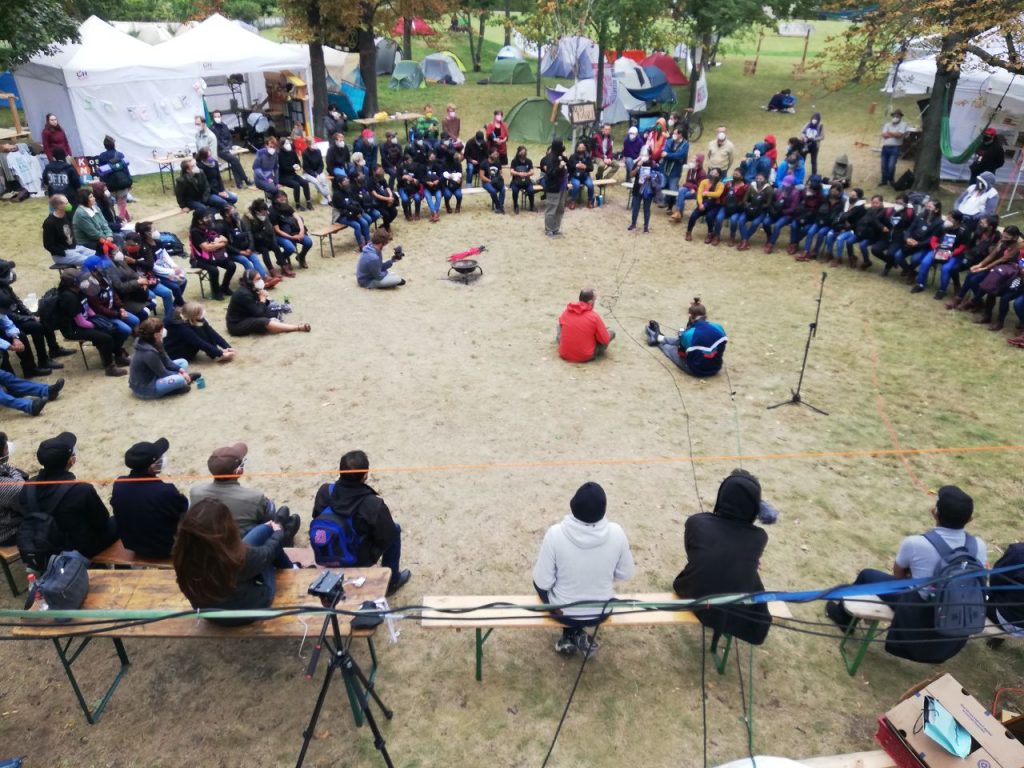
Among interventions and questions from both sides, they discussed resistance strategies to defend the territory—they talked about pacifism, civil disobedience, occupation, and violence. Local activists explained that the entire movement in Lobau is pacific and that this is a fundamental condition to maintain the wide support from the community. Although most of the campers are young, neighbours have collaborated and helped, allowing, for example, the camping youth to shower in their homes.
There was even an agreement with the police so that, if the protest remained non-violent, they would warn the occupiers with one day notice in case of an eviction order.
If this is strange for someone who comes from a geography in the south of Europe and, daily, sees images of police violently repressing and assaulting a defenceless population, we can’t imagine how strange it sounds for someone from Mexico, where violence is a daily certainty, and police just another force of repression and gratuitous violence.
“And if you don’t leave?”, ask the Zapatistas.
They explain that, if they face an eviction order and don’t leave on their own, they would be detained for 24 hours and then released, without any accusation. Which means that “nothing happens and we camp again.”
“It’s as if I would tell you ‘I’m going to beat you up,’ and you say ‘no, don’t do it,’ and then I don’t do it”, commented SubMoy, surprised, then asking if this type of actions has any results. The truth is that, since the beginning of the occupations in Lobau, the construction works for the highway and its accesses have stopped.
After a good hour where both the movements shared about themselves and exchanged ideas and impressions about resistance, the Zapatistas were given a tour of the camping site. They then departed to a second occupied site, whithin 15-minute walking distance—the construction yard with all the machines. There, the Zapatistas and the others present divided into two groups and they got to know the two camps set up there, smaller than the main one.
It was in one of those camps that all of them regrouped in front of a tower, built by the protesters, to record a video in support of the Lobau resistance.
Until, suddenly, it started to pour down and the dozens of people had to find shelter under a long canvas, which didn’t prevent most of them from getting soaked.
In that moment, most of the Zapatista compas decided to return to their accommodations. A group of Zapatista women housed in the Frauenzentrum (Women centre) decided to stay in Lobau while they waited for the lunch they had been invited to.
In that hour of waiting, there was another moment of discussion and exchange, this time more informal, in which the compas shared the history of the Zapatista movement since 1986, the preparation for the uprising of 1994, and the role of their health and education promoters, putting a special emphasis in the participation of women in the entire process. They also addressed the issue of alcohol consumption in the communities, the problems that arose from it in military as well as in family contexts, and how, as communities and peoples, they decided to confront it.
A compa mentions that “The Zapatistas have come to give hope and inspire us with everything they were already able to build in Chiapas. They are a true walking library.” Concluding, the Zapatistas stress that they are a pacific movement at the moment and that they are resisting taking up arms albeit the provocations.
The area of Lobau, in the Danube-Auen National Park, is what is left of an enormous humid ecosystem that extended along the margins of the Danube, destroyed in the process of earthmoving for the expansion and industrialization of the Austrian capital in the end of the 19th century.
It was in this special place that happened the first of the gatherings between Zapatistas and movements and resistances in the Unsubmissive Europe, the main goal of this first chapter of the Journey for Life. It was also in this National Park that, in 1984, took place one of the main processes of resistance in Austria’s recent history. The plan of building a hydroelectric powerplant in the Eastern limit of the park sparked a wave of protests that culminated, in December of that year, in an occupation of the site that the machines were ready to destroy. On the 8th of December, 8000 people demonstrated at the site and a few hundred started a permanent occupation of the space, forcing the construction to be stopped.
On the 19th of December, a contingent of 800 police officers expelled violently the 3000 protesters that remained on site. The confrontations resulted in two dozen injured and a wave of outrage in Vienna, where 40 thousand people demonstrated that same night. Fearing a revolt, the government announced the suspension of the project a couple of days after and, in the beginning of January, the Supreme Court announced the prohibition of any construction in the area. The occupation was ended and, months later, the project was definitely abandoned.
This struggle is remembered as one of the most important moments of the democratic process in Austria, and it was the first time that civil disobedience was widely accepted as a strategy to assert the people’s will against the intentions of the bad government. Since that year, almost all mega-projects in Austria have faced some degree of popular resistance. In 1996, the construction of a hydroelectric powerplant in Lambach was delayed due to an occupation and, in 2003, a similar project for the Lobau area was also stopped after a symbolic occupation of the site.
CNI and FPDTA arrive in Austria and join the EZLN for the Climate Strike demonstration in Vienna
The groups of Listening and Speaking that make up La Extemporánea started, on the 22nd of September, travelling to the geographies that constitute the first zone of this Journey for Life – Germany, Scandinavia, Eastern Europe and the Balkans. Late afternoon that same day, landed in Vienna the 16-people delegation of the National Indigenous Congress (CNI-CIG) and the Peoples’ Front in Defence of the Earth and the Water (FPDTA) that are joining the EZLN on this Journey.
Two days later, the delegation of CNI and FPDTA participated, alongside with dozens of zapatistas present in the city, in the Climate Strike demonstration. Twenty thousand people took to the streets of the Austrian capital demanding an urgent change to face the climate crisis.
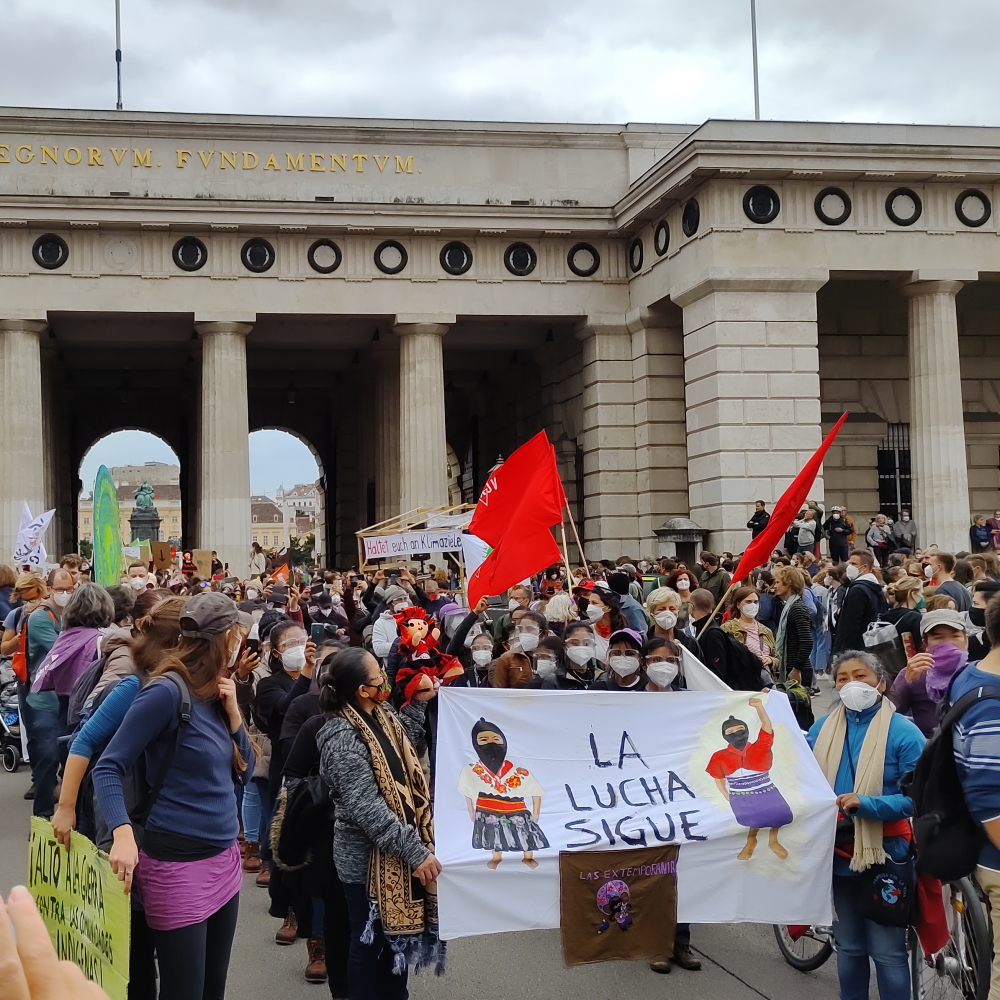
The demonstration left around 1pm from Praterstern and crossed Vienna’s large avenues in a 4km-long walk full of slogans in English and German demanding climate justice, urgent action to combat global warming, a system shift, and in support of the resistance in Lobau, in the outskirts of the city, against the construction of a highway in its most important natural reserve. It ended in the Austrian parliament, where the last demonstrators arrived two hours and a half after the beginning of the march.
After the speeches of the organization and the performance of a local band, the compas went on stage and shared the message of the Indigenous people in Mexico with thousands of people, in front of that same majestic balcony from where Hitler spoke in 1938, being applauded by hundreds of thousands of people and consummating the annexation of this territory by Nazi Germany.
This time the message was quite different. First spoke Libertad, a Zapatista compa who told the story of a woman.
It doesn’t matter the colour of her skin, because she has all the colours. It doesn’t matter her language, because she hears all languages. It doesn’t matter her race and her culture, because all ways of life inhabit her. It doesn’t matter her stature because she is big, and yet, fits in one hand. Every day and every hour, that woman is violated, beaten, hurt, raped, deceived, despised. A macho exerts his power over her, every day and every hour. She comes to us, shows us her wounds, her pains, her sorrow, and we only give her words of comfort, of pity, or we ignore her. Maybe, as a handout, we give her something to soothe her wounds, but the macho continues his violence.
We and you know how this will end. She will be murdered and, with her death, everything will die. We can continue giving her words of hope and remedies for her ailments. Or we can tell her the truth: the only medicine that can treat and cure her completely is to confront and destroy the one that violates her. And we can also, consequently, join her and fight by her side.
We, the Zapatista peoples, call this woman “Mother Earth”. For the macho that oppresses and humiliates her, use the name, face, and shape you want. We, the Zapatista peoples, call this assassin macho by a name: capitalism.
And we arrived in this geography to ask you: will we continue thinking that with ointments and tranquilizers we can solve the beatings from today, although we know that tomorrow the wound will be bigger and deeper? Or will we fight by her side?
We, the Zapatista communities, decided to fight alongside her, on behalf of her, and for her.
Libertad finishes her speech amidst applauses and chants of: “Ah, Anti, Anticapitalistas”. Isabel, an Otomi woman living in Mexico City, part of the CNI, then takes the floor and addresses the crowd, first in Otomi and then in Spanish:
Today we are seeing that those of us who live in the city don’t have the right to it, and those of us who live in our villages are dispossessed. There are many companies that have been cheating us about progress. We have the thermoelectric power station, the Mayan train, wind farms, the parents of Ayotzinapa, and the agrochemicals that here in developed countries are no longer sold and are taken to our villages to kill us all.
Today we are here, the peoples from the other side of the world to walk together. That’s why we, the Indigenous Council of Government, are walking next to our Zapatista sisters and brothers. This is a Journey for Life because, if Mother Earth perishes, if we kill her all together, we will perish with her, we will die with her. And so, we tell you, to capitalism and to the patriarchy, that the only thing we want is our autonomy, our villages, our waters free from contamination, our rivers. We don’t want more capitalism, we don’t want more companies. And we also say that we don’t forget and we don’t surrender and hasta la victoria… Zapata vive!
And the crowd responds: “La lucha sigue!”


Contrary to Hitler’s speech, these two speeches won’t be covered by the mass media, they won’t appear in history books, but they fulfil the function of, through listening and speaking, sowing that resistance and rebellion, which is the main goal of this Journey for Life.
These two Indigenous women, with their words, touched thousands of people, the majority of which were youths and children. Many are conscious of the problems of the world, critical of the capitalist system and anxious to see a change we know to be urgent and necessary but, in these European lands, we still don’t know how to build. In the heart of the beast, these two Indigenous women sowed in the new generation the hope and the certainty that the only way to avoid the collective collapse to which humanity—and the planet—are headed, is to organize and build that solidarity between peoples that doesn’t look at borders nor distances, and together walk towards this “world where many worlds fit.”
A little after these speeches, while another musical act started, the Zapatista compas, the CNI and the FPDTA, together with other people and supportive collectives, walked to the Mexican Embassy. As part of an action called for by the EZLN in their last statement, “Chiapas on the verge of civil war,” which happened that day in more than fifty cities around the world, the demonstration demanded an immediate stop to the attacks on the Zapatista communities in Chiapas, who have been the target of repeated aggressions and provocations by paramilitary groups with the support, when not the direct collaboration, of the federal and Chiapas governments.

During these days, behind closed doors, the Zapatistas, the CNI and the FPDTA held multiple other meetings of Listening and Speaking with Palestinian women, with Spanish and Portuguese-speaking women, and with other communities and struggles in Vienna, to discuss the matters that bring these indigenous peoples to Europe in this Journey for Life.

Parts of this article were based on collectively written notes by the independent media present in Vienna, originally published in Spanish and Portuguese in Radio Zapatista, Pozol.org and Guilhotina.info.







